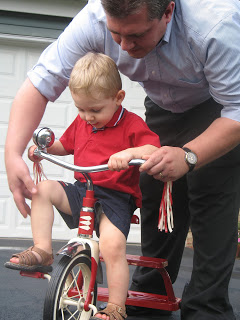Dr. Lisa’s Parenting Tip:
THE PUSH-PULL FACTOR
Signs it’s time to PUSH:
*Your child asks for your help. Kids often have remarkable clarity about what they need. We just need to be good listeners. Sometimes, however, they don’t and/or there is a question behind their question. For example, “I need your help,” may in fact be “I don’t know what is expected? I need more information.” or “I don’t believe I can do it,” or “I don’t want to do this all by myself.” You might then ask, “Is there a question behind your question, like something more you need to know before doing this?” Or, your could ask “How can I be most helpful?” Help your child to tell you at least one way that you might be able to help push them towards success. If they are stuck, then ask if you can offer some suggestions. Sometimes asking for help is about a need for parent-child connection, compassion, and/or the vulnerability inherent with developing the courage to try new things.
*Decide if it’s important to you both. Maybe you’d like your daughter to rock climb, but it isn’t her
thing. But, you believe learning an instrument is important for overall emotional and cognitive
development—even when the practices get dull and require big-time stick-to-itiveness and the occasional
push to practice. Differentiate between a dare and the genuine learning experience that courage
challenges can provide.
*Do they have all the necessary skills and capabilities? We can’t expect our kids to jump off the
diving board the first time they put on a swimsuit. Your role as a parent is to be your child’s
first teacher. Take the time to teach your child, step-by-step, the necessary skills associated with the
task at hand. You want your child to take responsibility with household chores, for example, walk them
through how you expect them to do each chore, teach them to fold laundry or load the dishwasher,
before asking them to do it on their own.
*Practice makes perfect. Rehearse and role-play with your child what it is you wish them to learn. The
more mental practice—the more assured success. Just ask any professional athlete trained in
psychological skills training (PST): a winner visualizes the race and the win before it happens (Weinberg
& Gould, 1999).
*Make sure the safety net is in place. Soon, you won’t be around to catch every fall. In fact, even if you are right there you may miss. The research is clear, kids raised in bubble wrap aren’t equipped to handle life’s bumps and bruises. But, you can ensure that your child knows how to ask for help and that he/she believes in his/her inherent worth—regardless of success or failure. Self-confidence is the strongest net of all.

*
You’ve dipped your toes in the water a few times and now it’s time to dive. The longer you wait; the more apprehension is bound to build. Strike while the iron is hot. Teach you child to pay close attention to their thinking and the signs in their body that signal readiness: “I can do this” thoughts, a fluttery heart combined with a conviction of purpose, a narrowing of the gaze on the goal in their mind’s eye, a feeling of excitement—even if it means reframing fear. (Based on the fact that excitement and anxiety trigger similar centers and neurotransmitter release in the brain and nervous system).
To summarize, let’s use the acronym: P.U.S.H.
P is for prepare for battle (make sure your child has the tools for success)
U is for understand the goal (make sure your child agrees the goal is important)
S is for safety net (make sure you have a back-up plan or a way to save face)
H is for
hope (make sure your child is inspired and confident in his/her thinking)
Okay…Get Ready, Get Set, PUSH!
Signs it’s time to PULL back:
*
Your kid asks you to back off. It can’t be said enough: kids have a lot of clarity. When we honor their boundaries and limit-setting, whilst empowering them to listen to themselves, we lend support to their natural impulse towards learning, curiosity, and openness to experience.
*Fear can’t be reframed as excitement. Fear is a life-saving signal to play close attention when danger is present—whether real or imagined. Flush out the monsters under the bed; listen to what they have to say about what’s really going on in your child’s head. If your child’s willingness to try new things suddenly or has never been very strong, you might even need help from a mental health professional in cases of clinically significant anxiety.
*Figure out whose goal it is? Do you feel incredible regret because you quit piano in grade school and now can’t play an instrument? Are you channelling your unmet desires in life into a pint-size version of yourself? What’s in it for your child? If you keep meeting with resistance and both of you can’t answer this question, honestly, it might be time to find a different goal or courage challenge.
*One or both of you believes the thought “I can’t do this.” It’s time to deconstruct a few of those self-defeating thoughts first. Instead of trying to fight your child’s fear or lack of self-confidence, take a different tact. What we notice, we get more of. Therefore, if we notice that they lack self-confidence and continue to focus on that lack, we will get more of it. Try asking, “Do you need more information about what I’m asking you to do? How can I help you break apart this task into smaller pieces, so it can feel more manageable?” Remind yourself and your child, “For every problem there is a solution. It’s just up to us to discover what that solution might be.”
Play the “What if…?” game to generate possible solutions and help extinguish fear and restore mental and emotional calm. You may be surprised by the insightful conclusion at the end of this game.
Parent: “What if you try to skateboard and you fall off?”
Child: “I might get hurt!”
Parent: “What if you get hurt?”
Child: “I’ll have to get you to find me a bandage or go to the doctor”
Parent: “What if you have to wear a bandage or go to the doctor?”
Child: “I might be embarrassed!”
Parent: “What if you are embarrassed?”
Child: “I might get really red in the face.”
Parent: “What if you get red in the face?”
Child: “I’ll look funny and probably make you laugh. And then I might laugh, too. But, I guess that would mean I was okay again.”
To summarize, let’s use the acronym: P.U.L.L.
 P
P is for
provide (make sure you provide and rehearse the tools for success, gently pace the number of new challenges or experiences you are providing, and then provide the freedom of choice to do it on their own)
U is for understand (make sure you both understand that the strongest of all motivational pulls is intrinsic—motivation that comes from within, not from some external prize (Pink, 2009)).
L is for listen (make sure you listen closely to your child’s words, what he/she needs to succeed, and focus on his/her strengths)
L is for love (make sure you love your child even when he/she is scared, angry, or confused and pushes you away. Love your child enough to let go in the moments they need to do it “all by myself!”)
Okay, Ready? Set? No? PULL BACK—either yourself or your child!
Weingberg, R. & Gould, D. (1999). Foundations of sport and exercise psychology. (2nd ed.). Champaign, IL: Human Kinetics.

 *You’ve dipped your toes in the water a few times and now it’s time to dive. The longer you wait; the more apprehension is bound to build. Strike while the iron is hot. Teach you child to pay close attention to their thinking and the signs in their body that signal readiness: “I can do this” thoughts, a fluttery heart combined with a conviction of purpose, a narrowing of the gaze on the goal in their mind’s eye, a feeling of excitement—even if it means reframing fear. (Based on the fact that excitement and anxiety trigger similar centers and neurotransmitter release in the brain and nervous system).
*You’ve dipped your toes in the water a few times and now it’s time to dive. The longer you wait; the more apprehension is bound to build. Strike while the iron is hot. Teach you child to pay close attention to their thinking and the signs in their body that signal readiness: “I can do this” thoughts, a fluttery heart combined with a conviction of purpose, a narrowing of the gaze on the goal in their mind’s eye, a feeling of excitement—even if it means reframing fear. (Based on the fact that excitement and anxiety trigger similar centers and neurotransmitter release in the brain and nervous system).


Isn't it such a fine line sometimes though?
I couldn't agree with you more ThaiHoa.That's why nurturing a secure attachment, open and loving communication with your child, knowing your own child and his/her particular temperament, and trusting your gut as your child's parent is so important.This post only outlines some general guidelines and questions to consider about when to push and when to pull back, depending on your child and the task(s)/challenge(s) at hand.Over time, it is important to look for trends in the six types of courage that come more easily, and those that may not with our particular child.Reviewing the social, emotional, physical, moral, intellectual, or spiritual courage types (listed on our website) can be helpful to identify areas of strength and those that may be in need of strengthening.